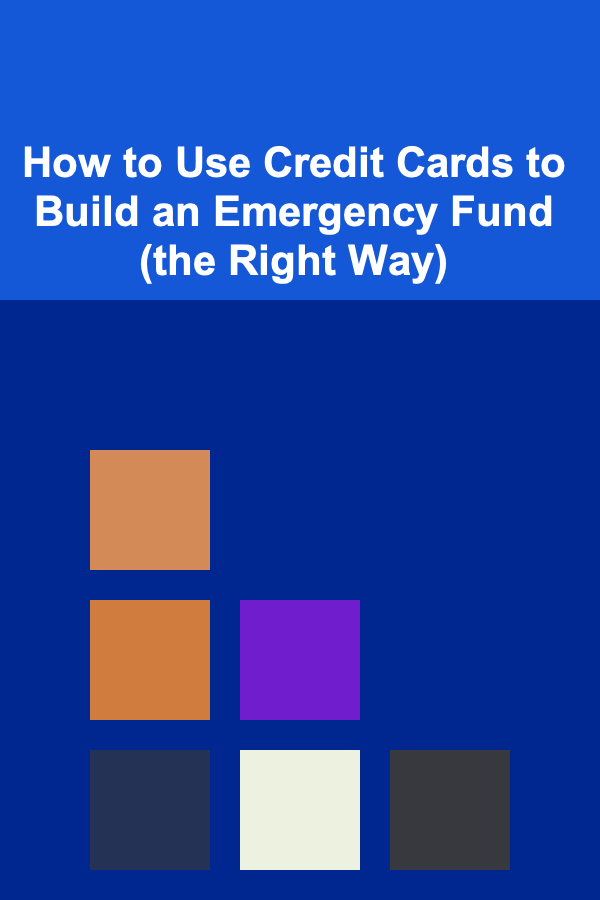
How to Use Credit Cards to Build an Emergency Fund (the Right Way)
ebook include PDF & Audio bundle (Micro Guide)
$12.99$6.99
Limited Time Offer! Order within the next:

Building an emergency fund is one of the cornerstones of financial security. An emergency fund acts as a safety net, providing you with the necessary funds to handle unexpected situations, such as job loss, medical emergencies, or urgent repairs. However, for many people, saving enough money to create a substantial emergency fund can be a challenge, especially when juggling day-to-day expenses or dealing with existing debt.
While traditional advice often emphasizes the importance of saving through a savings account, one powerful tool often overlooked is the credit card. When used strategically, credit cards can be an effective way to assist in building an emergency fund, helping you stay financially secure without falling into debt.
This article will explore how you can use credit cards to build an emergency fund responsibly, without putting yourself at risk of financial hardship. We will examine the benefits and risks, strategies for using credit cards to build savings, and how to avoid common mistakes.
Understanding the Role of an Emergency Fund
Before delving into how credit cards can assist with building an emergency fund, it's important to understand what an emergency fund is and why it's essential.
1.1. What is an Emergency Fund?
An emergency fund is a pool of money set aside to cover unexpected financial expenses. This fund serves as a buffer for situations that could disrupt your normal income flow or require immediate financial attention. Common examples of emergencies that necessitate an emergency fund include:
- Medical bills: Unexpected illnesses, accidents, or medical treatments.
- Car repairs: Sudden breakdowns or repairs that can't be delayed.
- Job loss: Temporary loss of income while you search for a new job.
- Home repairs: Unexpected problems with your home, such as plumbing or electrical failures.
An emergency fund provides peace of mind and reduces the need to rely on credit cards or loans during such times. It is often recommended to have three to six months' worth of living expenses saved in an easily accessible account.
1.2. Why Building an Emergency Fund is Important
Having an emergency fund ensures that you are prepared for unexpected situations, preventing you from relying on high-interest credit cards or loans to cover urgent costs. This fund can:
- Provide financial stability: It helps you manage unexpected expenses without disrupting your financial goals.
- Reduce stress: Knowing that you have a cushion to fall back on during tough times reduces anxiety about financial uncertainty.
- Prevent debt: With an emergency fund, you won't need to borrow money or use credit cards to cover emergencies, helping you avoid high-interest debt.
The Role of Credit Cards in Financial Planning
Credit cards are often seen as a source of debt rather than a financial tool. However, when used responsibly, credit cards can provide benefits that aid in building an emergency fund. Here's why:
2.1. The Power of Credit Cards
Credit cards offer several advantages that can support financial goals, including building an emergency fund:
- Access to immediate credit: Credit cards allow you to borrow money up to a set limit. If you don't have an emergency fund and an unexpected expense arises, your credit card can serve as a temporary solution.
- Rewards programs: Many credit cards come with rewards programs, such as cashback, points, or miles. If you're able to use a credit card for everyday expenses, these rewards can help offset the cost of building an emergency fund or save for future expenses.
- Interest-free periods: Many credit cards offer a 30-day grace period during which no interest is charged on new purchases, giving you a short time to pay off your balance without incurring extra costs.
- Purchase protection: Some credit cards offer purchase protection, extended warranties, and insurance for items bought with the card. This could help reduce the costs of certain emergencies, such as a broken appliance or damaged electronics.
2.2. How Credit Cards Can Help Build an Emergency Fund
Although it's not advisable to rely entirely on credit cards, there are situations where they can be used effectively as part of a strategy for building an emergency fund:
- Financing emergencies in the short term: If you're in the process of building your emergency fund but face a financial emergency, you can use a credit card to cover the immediate cost while continuing to save for the fund. The key is to pay off the credit card balance as quickly as possible to avoid interest.
- Earning rewards for everyday purchases: By using a rewards credit card for your regular expenses, such as groceries, gas, or utility bills, you can accumulate cashback or points. These rewards can either be used for future savings or help you reduce some of your living expenses, allowing you to put more money into your emergency fund.
- Emergency fund strategy: If you're disciplined, you can use your credit card to cover emergency expenses while simultaneously saving for an emergency fund. The goal is to pay off your credit card balance as soon as possible, so you're never carrying debt for long.
Strategies for Using Credit Cards to Build an Emergency Fund
Using credit cards to build an emergency fund requires careful planning, discipline, and strategy. Here are a few key approaches to do this effectively:
3.1. Use Credit Cards Only for Planned Purchases
The most responsible way to use a credit card for building an emergency fund is by using it for planned purchases. This means using the card for daily expenses that you can comfortably afford to pay off at the end of the month.
- Stick to your budget: Keep track of your credit card spending, ensuring that you only use the card for necessary expenses that fit within your monthly budget.
- Pay off your balance: Aim to pay off the balance in full every month to avoid interest charges and debt accumulation. The rewards you earn should be seen as a bonus, not a justification to overspend.
3.2. Use Rewards to Contribute to Your Emergency Fund
If your credit card offers a rewards program, use it strategically to generate extra savings for your emergency fund. Cashback or points can be transferred into a savings account, used to offset other living expenses, or reinvested into your savings.
- Redeem cashback or points regularly: If your card offers cashback, redeem the rewards on a regular basis and direct the funds into your emergency savings account.
- Take advantage of sign-up bonuses: Many credit cards offer sign-up bonuses, which can give you a significant lump sum of money that can be put directly into your emergency fund.
3.3. Use 0% APR Promotions Wisely
Some credit cards offer 0% APR (Annual Percentage Rate) for a promotional period, often between 12 and 18 months. This can be a useful tool for financing emergency expenses while you build your emergency fund. However, it's essential to pay off the balance before the promotional period ends, as interest will start accruing after that.
- Plan your repayments: If you need to use your credit card for an emergency, ensure that you have a clear repayment plan. Divide the amount you need to repay by the number of months in the promotional period to understand your monthly repayment obligation.
3.4. Avoid Overusing Credit Cards for Everyday Spending
While it's tempting to use your credit card for all daily purchases to maximize rewards, this can lead to overspending and debt accumulation. Stick to your budget and only use the card for planned purchases.
- Set a spending limit: To avoid spending beyond your means, set a monthly spending limit on your credit card that aligns with your income and savings goals.
- Track your spending: Use budgeting apps to track your spending and make sure you stay on top of your credit card usage.
3.5. Pay Off Your Credit Card Balance Regularly
The key to using a credit card without falling into debt is paying off your balance in full every month. This avoids interest charges and ensures you're not carrying high-interest debt that will offset any benefits from using the card.
- Set up automatic payments: To avoid forgetting to make payments, set up automatic payments for at least the minimum payment or, ideally, the full balance.
Potential Risks of Using Credit Cards
While credit cards can help you build an emergency fund, they also come with risks. Understanding these risks and taking steps to mitigate them is crucial to using credit cards responsibly.
4.1. Accruing High Interest and Debt
If you're unable to pay off your credit card balance in full each month, you could accumulate high-interest debt. This can quickly outweigh the benefits of using the card, as credit card interest rates are often quite steep.
4.2. Over-reliance on Credit Cards
If you use credit cards to finance multiple expenses without a plan to repay the debt, you risk becoming reliant on credit cards, which can derail your financial goals and prevent you from building your emergency fund.
4.3. Damaging Your Credit Score
Using credit cards irresponsibly can damage your credit score. Missed payments or carrying high balances relative to your credit limit can negatively impact your credit, making it harder to secure loans or credit in the future.
Conclusion
Using credit cards to build an emergency fund is a strategy that can work when executed thoughtfully and with discipline. While credit cards should not be relied upon as a long-term savings tool, they can provide a temporary bridge during emergencies and help you earn rewards that can contribute to your financial security.
By understanding how to use credit cards responsibly, creating a clear repayment plan, and avoiding common pitfalls, you can use credit cards as part of a broader strategy for building a strong emergency fund. The key is to remain disciplined and always ensure that you're paying off your balances to avoid falling into debt.

How to Create a Family Art Gallery with Homemade Projects
Read More
How to Decorate for the Holidays When You Have Pets
Read More
How to Make a Checklist for Selecting the Right Research Methodology
Read More
How to Set Up a Budgeting Station at Home
Read More
How to Understand Dating Etiquette in the Modern Age
Read More
How to Use Furniture with Built-In Storage for Small Homes
Read MoreOther Products

How to Create a Family Art Gallery with Homemade Projects
Read More
How to Decorate for the Holidays When You Have Pets
Read More
How to Make a Checklist for Selecting the Right Research Methodology
Read More
How to Set Up a Budgeting Station at Home
Read More
How to Understand Dating Etiquette in the Modern Age
Read More